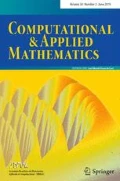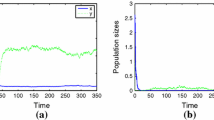Abstract
The predator–prey model with distributed delay is stated in present paper. On the basis of geometric singular perturbation theory, the transition of the solution trajectory is illuminated, and the existence of the relaxation oscillation is proved. It is indicated the characteristic of the relaxation oscillation is dependent on the structure of the slow manifold. Moreover, the approximate expression of the relaxation oscillation and its period are obtained analytically. One case study is given to demonstrate the validity of theoretical results.





Similar content being viewed by others
References
Chen Y, Yu J, Sun C (2007) Stability and Hopf bifurcation analysis in a three-level food chain system with delay. Chaos Solitions Fract 31:683–694
Fenichel N (1974) Asymptotic stability with rate conditions. Indiana Univ Math J 23:1109–1137
Fenichel N (1979) Geometric singular perturbation theory for ordinary differential equations. J Differ Equ 31:53–98
Freedman HI, Wolkowicz GSK (1986) Predator–prey systems with group defence: the paradox of enrichment revisited. Bull Math Biol 48(516):493–508
Holling CS (1959) Some characteristics of simple types of predation and parasiti sm. Can Entomol 91(7):385–398
Jones C (1994) Geometric singular perturbation theory in dynamical systems. Springer, Berlin
Liu WS, Xiao DM, Yi YF (2003) Relaxation oscillations in a class of predator–prey systems. J Differ Equ 188:306–331
Ludwig D, Jones D, Holling CS (1978) Qualitative analysis of insect outbreak systems: the spruce budwormand forest. J Anim Ecol 47:315–332
Ma ZP, Liu HFHCY (2009) Stability and Hopf bifurcation analysis on a predator–prey model with discrete and distributed delays. Nonlinear Anal Real Word Appl 2009(10):1160–1172
Mishchenko EF, Rozov KhN (1980) Differential equations with small parameters and relaxation oscillations. Plenum, New York
Muratori S, Rinaldi S (1989) Remarks on competitive coexistence. SIAM J Appl Math 49:1462–1472
Rasmussen A, Wyller J, Vik JO (2011) Relaxation oscillations in spruceCbudworm interactions. Nonlinear Anal Real World Appl 12:304–319
Rizaner FB, Rogovchenko SP (2012) Dynamics of a single species under periodic habitat fluctuations and Allee effect. Nonlinear Anal Real Word Appl 13:141–157
Rozov NKh (1962) Asymptotic computation of solutions of systems of second-order differential equations close to discontinuous solutions. Soviet Math Doklady 3(4):932–934
Sun C, Lin Y, Han M (2006) Stability and Hopf bifurcation for an epidemic disease model with delay. Chaos Solitions Fract 30:204–216
Tikhonov A (1952) Systems of differential equations containing a small parameter multiplying the derivative. Mat Sb 31:575–586
Yu W, Cao J (2006) Stability and Hopf bifurcation analysis on four-neuron BAM neural network with time delays. Phys Lett 351:64–78
Zharov MI, Mishchenko EF, Rozov NKh (1981) On some special functions and constants arising in the theory of relaxation oscillations. Soviet Math Doklady 24(3):672–675
Zheng YG, Bao LJ (2014) SlowCfast dynamics of tri-neuron Hopfield neural network with two timescales. Commun Nonlinear Sci Numer Simulat 19:1591–1599
Author information
Authors and Affiliations
Corresponding author
Additional information
Communicated by Maria do Rosario de Pinho.
Project supported by the National Science Foundation of China (Grant No. 11401385).
Rights and permissions
About this article
Cite this article
Wang, N., Han, M. Relaxation oscillations in predator–prey model with distributed delay. Comp. Appl. Math. 37, 475–484 (2018). https://doi.org/10.1007/s40314-016-0353-5
Received:
Accepted:
Published:
Issue Date:
DOI: https://doi.org/10.1007/s40314-016-0353-5




